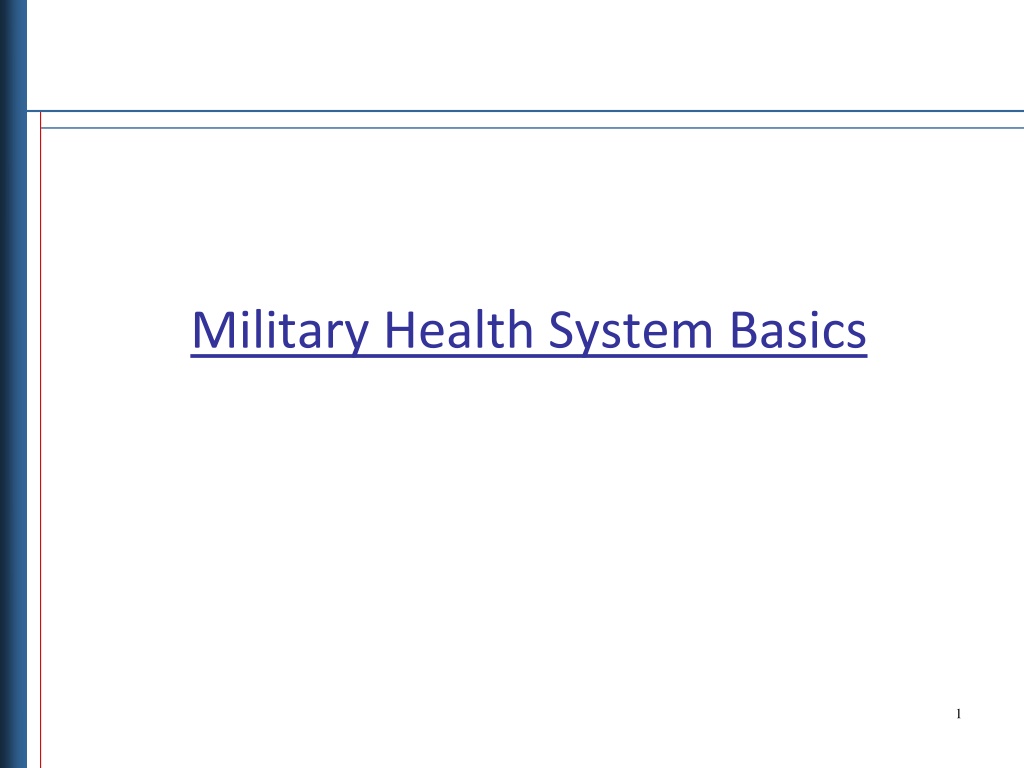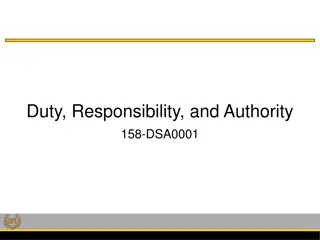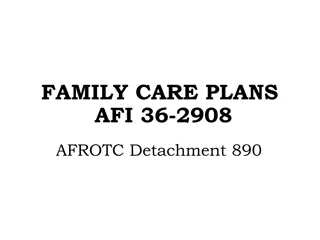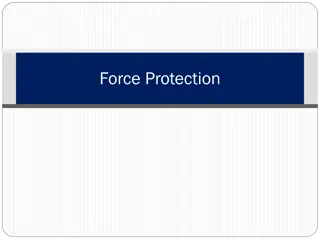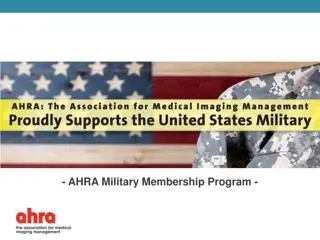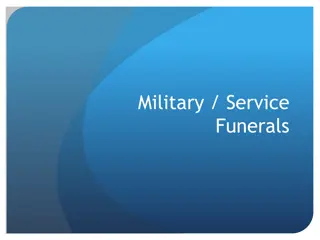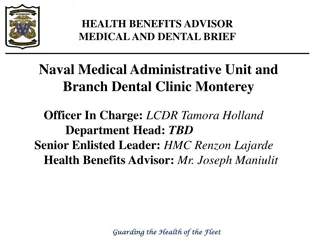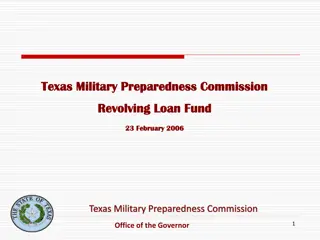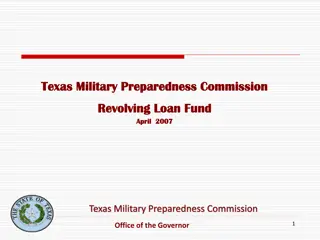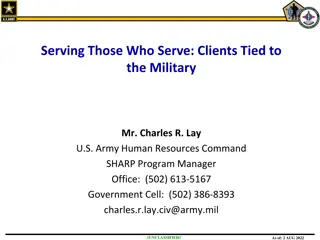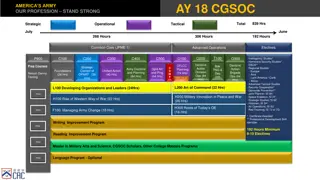Understanding the Basics of the Military Health System (MHS)
The Military Health System (MHS) ensures medical readiness of Service members, clinical readiness of healthcare providers, and provides healthcare coverage to eligible beneficiaries. It encompasses direct care in MTFs and purchased care in external settings, like TRICARE. Eligibility, enrollment trends, data availability, out-of-pocket costs, and differences between direct and purchased care are essential aspects covered in the MHS.
Download Presentation

Please find below an Image/Link to download the presentation.
The content on the website is provided AS IS for your information and personal use only. It may not be sold, licensed, or shared on other websites without obtaining consent from the author. Download presentation by click this link. If you encounter any issues during the download, it is possible that the publisher has removed the file from their server.
E N D
Presentation Transcript
MHS Basics Objectives Describe the Military Healthcare System (MHS), to include Direct and Purchased Care Systems Describe the TRICARE Benefit, eligibility requirements, and trends in eligibility and enrollment Characterize how eligibility and enrollment can impact availability of data Discuss out of pocket costs for the various programs Discuss high level differences between direct and purchased care 2
What is the MHS? The Military Health System: Ensures medical readiness of Service members Ensures clinical readiness of healthcare providers Provides healthcare coverage to eligible beneficiaries through a system of acute care hospitals and clinics, and through health plans. 4
What is the MHS? Direct Care System Care provided in hospitals and medical and dental clinics operated by the Military Health System or Care provided by providers assigned to military hospitals or clinics in external settings. Called External Resource Sharing. (The MHS has some resource sharing programs with the VA) Does not include Combat Support Hospitals, clinics on Navy ships, or other line operated medical care. Military Medical Treatment Facility (MTF) 5
What is the MHS? Direct Care Direct care access is the default eligibility for those who are entitled to care But most beneficiaries also have some sort of health plan through the MHS for care provided in the private sector There are access priorities at MTFs, with some patients deemed Space Available. Those who use the VA are often Space Available. Care at MTFs is free Hospitals and clinics are of varying capabilities; some are limited in scope. There are access standards for some categories of patients and some types of visits. If MTFs cannot meet the access standards, they must refer patients for care in the private sector. 6
What is the MHS? Direct Care Direct Care MTFs have historically been run by the three Services, depending upon the affiliation of the MTF. The MHS has been directed by Congress to change so that the Defense Health Agency operates MTFs. As of FY2019, 8 MTFs are run by DoD with more to come. The Military Service Surgeon Generals remain responsible for readiness. Currently many policies are Service-specific. This change (along with the implementation of MHS Genesis) should help standardize operations and data collection. 7
What is the MHS? Purchased Care Care purchased for TRICARE beneficiaries from TRICARE network and non-network providers. Civilian providers + VA. Represents more than half of the care that MHS beneficiaries receive. TRICARE uses a claims process, similar to Medicare, to pay for Services. TRICARE s payment systems are required to follow Medicare s. There are some differences, however. Purchased care benefits depend on which TRICARE health plan a beneficiary opts to enroll in. 8
What is the MHS? Who is Entitled for Care in the MHS? Active Duty Service Members and their family. Spouses, Children, Dependent Parents, etc. Guard and Reserve and their family, when activated for 30 days or more. Eligibility extends beyond the activation window. Retirees and their family. Generally must have served 20 years or more, or have been medically retired. Some buy-outs Survivors Some unremarried former spouses of Service members Medal of Honor winners Traditional Guard/Reserve Eligibility Period 30 days Call-Up Period (on Active Duty) 6 months of TAMP 9
What is the MHS? Additional means of eligibility TRICARE also offers eligibility for purchase to former dependents up to the age of 26 and for inactive guard/reserve. These beneficiaries would not otherwise have any eligibility for direct or purchased care. TRICARE calls these fee programs because fee program enrollees pay a premium in exchange for their eligibility. Ineligible patients are also sometimes treated in the direct care system. Usually on a reimbursement basis, but not always. For example, the San Antonio Military Medical Center serves as the main shock/trauma center for the city, even when patients are not eligible. There are large pockets of VA patients at some hospitals, like Travis in Sacramento and Tripler in Honolulu. 10
What is the MHS? MHS Eligible Beneficiaries About 9.5 million eligible beneficiaries MHS retirees and guard/reserve often use the VA Many active duty beneficiaries will become VA eligible. 11
What is the MHS? Prior to January 2018, direct care eligibility also included default fee for service purchased care coverage TRICARE Standard was a traditional indemnity insurance plan for beneficiaries who had not aged into Medicare. TRICARE for Life is a Medicare Wraparound for military retirees and their families. Beneficiaries did not have to enroll in either program. After January 2018, the only remaining default coverage is direct care and TRICARE for Life. All other eligibility requires enrollment with the MHS. 12
Health Plans Select: Indemnity/PPO insurance. Replaced Standard/Extra in Jan 2018. Annual enrollment required. Available for beneficiaries who have not aged into Medicare. New accessions after 1/1/2018 will have to pay premiums for Select upon retirement. There is language in the authorization for Select that may authorize the Department to charge premiums for some types of patients later . Must be studied by GAO. There is a network of providers for Select. The Network must be sized so that access standards are met for 85% of Select enrollees. No PCM or referral requirements. Out of pocket costs depend on the type of beneficiary. More later. TRICARE Select enrollees often have other health insurance. 13 https://www.congress.gov/bill/114th-congress/house-bill/4909/text
Health Plans TRICARE Prime: 4.5+ million member Health Maintenance Organization. Annual enrollment required. Available for beneficiaries who have not aged into Medicare. TRICARE Prime is only offered in Prime Service Areas . TRICARE Prime Remote is also available. TRICARE Prime beneficiaries have access guarantees whether care is provided in direct care or purchased care. (24 hours for acute needs, a week for routine care, 28 days for specialty or wellness care) TRICARE Prime beneficiaries are the highest access priority at MTFs. Beneficiaries are assigned a PCM to manage their care, either at an MTF or with a purchased care provider. The PCM is also responsibility for referring patients to purchased care if the MTF cannot meet access standards. TRICARE Prime enrollees have low levels of other health insurance. 14 https://www.congress.gov/bill/114th-congress/house-bill/4909/text
Health Plans TRICARE Select and Prime: TRICARE has two managed care support contractors (MSCSs) who help administer TRICARE Prime and TRICARE Select benefits. Claims payment Referral management Establishment of networks to meet access standards for Prime and Active Duty, and for 85% of TRICARE Select enrollees Disease and Case Management Enrollment MTF Optimization TRICARE is organized into Regions, associated with these contracts. Regions East and West. TRICARE has a contractor overseas to administer the benefits to overseas beneficiaries. 15 https://www.congress.gov/bill/114th-congress/house-bill/4909/text
Health Plans Designated Provider A Prime Program where TRICARE beneficiaries give up their access to both direct and purchased care in exchange for Prime-equivalent coverage with a specific provider. 6 Healthcare Providers in the US hold Designated Provider Contracts. Designated Providers are paid a risk-adjusted capitation rate to cover the cost of care. Claims are not used for this program, but encounter data is provided by the contractor. Requires annual enrollment. Available for beneficiaries who have not aged into Medicare. There are some grandfathered Medicare beneficiaries enrolled with Designated Providers, but no new Medicare beneficiaries are being accepted. After each enrollment period, a beneficiary can decided whether to stay with the Designated Provider, or go back to regular TRICARE. 17 https://www.congress.gov/bill/114th-congress/house-bill/4909/text
Health Plans TRICARE Fee Programs Fee program enrollees are purchasing both direct and purchased care. The access priorities for fee program enrollees are the same as those who get access via entitlement rather than purchase. TRICARE Young Adult: Can purchase TRICARE Prime or TRICARE Select. TRICARE Reserve Select (TRS) and TRICARE Retiree Reserve Select (TRR) Can only purchase TRICARE Select. Guard and Reserve members can purchase the fee programs outside of the normal eligibility window. If they do not purchase TRS, they are not eligible for anything other than line of duty care with the MHS (until retirement at age 60 for those with 20+ years). 30 days Call-Up Period (on Active Duty) 6 months of TAMP 18
Health Plans TRICARE for Life Medicare wraparound for TRICARE Retirees Paid for with an accrual fund. Beneficiaries are eligible for TFL if they age into Medicare, have a retired sponsor and purchase Medicare Part B. No enrollment with the MHS is required. Includes direct care access, and Medicare serves as first payor for purchased care, then TRICARE covers the out of pocket costs. TRICARE only sees claims for this cohort if there is an out of pocket payment. Healthcare is virtually free for this cohort. Medicare eligible beneficiaries do have direct care access, but are generally the lowest priority for care. 19
Health Plan Membership TRICARE Retiree Reserve Select is not accurately represented currently. This is being investigated. 20
TRICARE Pharmacy The TRICARE Pharmacy Benefit has changed over the years Retail Pharmacy is the most costly to TRICARE, so TRICARE has been changing the benefit to try to steer beneficiaries to mail order or MTFs. A mandatory mail-order maintenance drug program was recently introduced for all non-active duty. Retail Network Pharmacy (Typically 30-day fills) $11 $28 $53 TRICARE Mail Order Pharmacy (Typically 90-day fills) $7 $24 $53 MTF Pharmacy $0 $0 $0 Type Tier 1 (Generic) Tier 2 (Preferred Brand) Tier 3 (Non-Preferred Brand) Drugs filled at non-network retail pharmacies are subject to deductible and 50% cost-share 21
TRICARE Plus TRICARE Plus TRICARE Plus is not a health plan but does impact access to care priorities. TRICARE Plus patients are empaneled with a PCM at an MTF. Available for anyone not on Active Duty. TRICARE Plus is a free program that gives preferred access to primary care over other non-Active Duty, non-Prime patients, on paper. MTFs use TRICARE Plus to enroll more complex patients so that providers can practice their skills. 85% of enrollees are Medicare eligible. 22
TRICARE for Active Duty Active Duty = Regular Active Duty + Activated Guard Reserve during the call-up period. Active Duty at a permanent duty station must enroll in Prime. TRICARE Prime or TRICARE Prime Remote The overwhelming majority of AD are enrolled at an MTF. Some are enrolled with an Operational Forces PCM, that is, a line provider. No enrollment fees or cost sharing for any covered care for active duty, including prescription drugs All non-emergency room care received outside the MTF must be referred by a PCM, including urgent care. 23
TRICARE for Active Duty Family Members ADFM = Family of Active Duty + Guard/Reserve family during call-up period. ADFMs must enroll in a health plan to receive purchased care coverage. ADFMs in Prime/Designated Provider generally do not face cost sharing. Two exceptions: Point of Service (POS) care, non-emergency out-of-network care; ADFMs pay a deductible and then 50 percent of allowable charges Copays for prescription drugs filled outside of the MTF Select ADFMs do have cost sharing for civilian care: in 2018 $21 for primary care $31 for specialists $81 for ER $25 per inpatient admission small annual deductible ($150 for individuals, $300 for families). Catastrophic cap of $1,000 limits out-of-pocket costs (excluding POS) 24
TRICARE Prime TRICARE Select TRICARE beneficiaries not on Active Duty or TRICARE for Life (65+) who are not in TRICARE Prime Free Who Can Enroll Annual Enrollment Fee any ADFM can enroll in Prime Free Must select a PCM who manages referrals to other providers; MTFs can have right of first refusal for enrollment and referrals PCM and referrals are not required; some services require prior authorization $150 for individuals; $300 for families Higher for out-of-network care, lower for family members of active duty ranks E-4 and below ADFMs: $21 for primary care, $31 for specialist care, $81 for emergency room care Care Management Annual Deductible No Deductible in-network Office Visit Copays No Copays Point of service option: $300/600 deductible, then 50% of allowed charges Out of Network Care 25% of allowed charges $25 per admissions Inpatient Admissions No cost-share $1,000 per family Does not include POS care Catastrophic Cap Same levels as TRICARE Prime 25
TRICARE for Retirees, their Families and Survivors Must choose to enroll in either TRICARE Prime or Select to receive civilian healthcare. Same pharmacy copays as for ADFMs Higher catastrophic cap of $3,000 For sponsors who entered service after January 1, 2018, cost sharing and enrollment fees are higher. This is a very small group at present, but will increase over time. 26
TRICARE for Retirees and their Families TRICARE Prime Any retiree/family who has not aged into Medicare eligbility TRICARE Select Any retiree/family who has not aged into Medicare eligbility Who Can Enroll $289 for single retirees, $578 for family in 2018 (for most) Must select a primary care manager, who manages referrals to other providers; MTFs can have right of first refusal for enrollment and referrals Currently $0; retirees likely to pay about 40 percent of Prime enrollment fee starting January 1, 2021 Annual Enrollment Fee PCM and referrals are not required; some services require prior authorization $150 for individuals; $300 for families Higher for out-of-network care, lower for family members of active duty ranks E-4 and below $28 for primary care, $41 for specialist care, $109 for emergency room care Care Management Annual Deductible No Deductible in-network $20 for primary care, $30 for specialists, $60 for emergency room care Point of service option: $300/600 deductible, then 50% of allowed charges $150 per admission Retirees: $3,000 per family Does not include POS care Office Visit Copays Out of Network Care Inpatient Admissions 25% of allowed charges Retirees: $250 per day Catastrophic Cap Same levels as TRICARE Prime Cost sharing is higher for a small group of retirees who entered service after 1/1/2018 and lower for medically retired families and survivors 27
TRICARE for Guard/Reserve During call-up period, Guard/Reserve are the same as active duty. During 30 days pre-call-up and 6 months after, inactive Guard/Reserve have default direct care coverage and can enroll in Prime or Select. Otherwise, inactive Guard/Reserve have no eligibility unless they purchase TRICARE Reserve Select (TRS). Benefit matches the ADFM TRICARE Select benefit (for those who entered service in 2018 and beyond) Enrollment fee is subsidized by the government, so enrollees pay only 28% of the cost of the plan ($46/mo. for individuals and $221/mo. for families) Nearly 400,000 enrollees Many of these beneficiaries also use the VA. 28
TRICARE for Guard/Reserve After 20 years or service, reservists receive full TRICARE benefits (same as non-reserve retirees) when they reach 60 years of age). Prior to age 60, retired reservists can purchase TRICARE Retired Reserve (TRR). Benefit matches the non-active duty family member TRICARE Select benefit. Not subsidized, so enrollment fees are higher: $431/mo. for individual, $1,084/mo. for families 29
Access Priorities for MTF care Access priorities for care at MTFs are defined in the law The priorities are: 1. Active Duty (line of injury and disability) and authorized Foreign Military 2. Active Duty Family enrolled in Prime and authorized NATO family 3. Retirees, their Families and Survivors enrolled in Prime and TRICARE Plus for Primary care only 4. Active Duty Family not in Prime 5. Retirees, their Families and Survivors not enrolled in Prime. 6. Others Beneficiaries who can t be treated in direct care use a lot of purchased care! 30
TRICARE Dental Coverage Active Duty receive care through the direct care system and the Active Duty Dental Program (ADDP): No premiums or cost sharing ADDP provides a network of civilian providers for services not available at direct care facilities TRICARE Dental Program is a voluntary, premium-supported plan, for ADFMs, and reservists and their families. Benefits are similar to commercial dental plans (significant cost sharing) ADFMs and Reserve sponsors are subsidized. For ADFMs, 2018 monthly premiums are $11 for individuals and $29 for families Provided through United Concordia Retirees have historically had access to the TRICARE Retiree Dental Program, but as of January 1, 2019, retirees will be eligible to purchase into the Federal Employees Dental and Vision Insurance Program (FEDVIP). 31
Direct Care vs. Purchased Care Direct care MTFs are located on or near military bases. There are about 375 direct care medical clinics, 50 direct care hospitals and about 250 dental clinics. All are acute care only, some limited in scope. Some offer GME. All care is free at MTFs. Operational and clinical data are available when patients are treated in direct care. Purchased care plans satisfy ACA requirements for health insurance. Includes acute care and non-acute care. Costs of care vary based on the beneficiary category and which health plan a patient enrolls in. Claims data are available only, and if the patient has OHI, only available when TRICARE has a liability. Studies have shown that cost-sharing impacts utilization. 33
